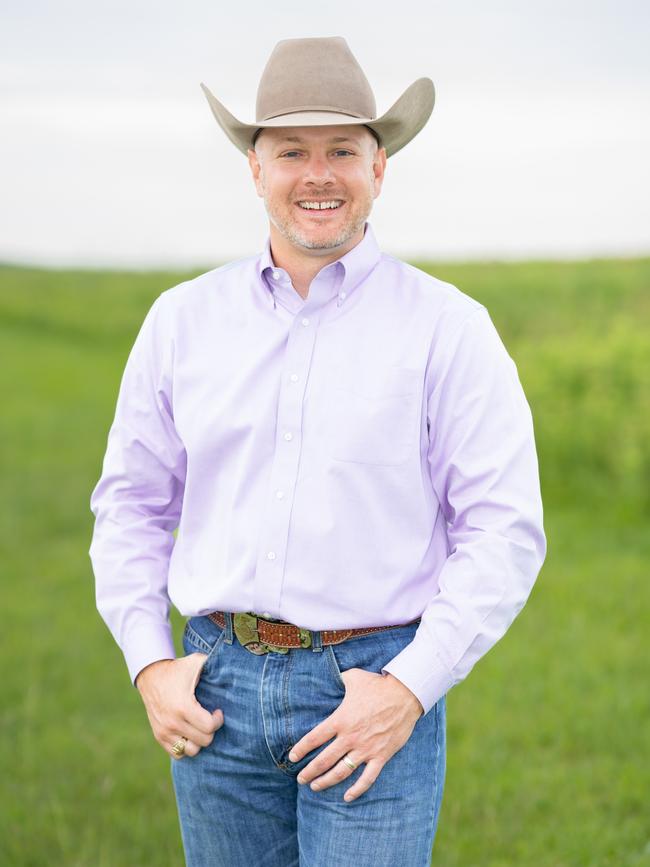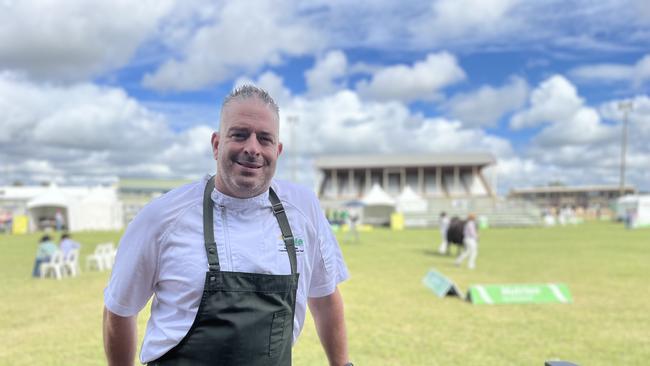Beef Australia 2024 kicks off in Rockhampton
Producers have been assured that there are extensive plans in place should there be an emergency disease outbreak in Australia, but that there is no such thing as zero risk.
Producers have been assured that there are extensive plans in place should there be an emergency disease outbreak in Australia.
And a seminar at Beef 2024 was told there was no such thing as zero risk and that producers needed to make their own strong biosecurity plans to protect themselves from fallout should a disease like Foot and Mouth be found in Australia.
Queensland cattle producer Brigid Price said for their beef farming operation, “biosecurity is life security”.
Ms Price, who is part of a family operation running about 1200 cows in an organic system in the Injune district, said they had an extensive biosecurity plan that they actively used.
“It is not just a plan that sits on a shelf,” Ms Price said.
“And a lot of things in that plan are now things we do automatically.”
This included ensuring that visitors to the farm had third party proof that vehicles had been washed down before entering.
“Biosecurity is just something that we do and biosecurity is more than just what you see on the TV show Border Force.”
Ms Price said Australia’s dependence on the export market meant the issue of biosecurity needed to be taken very seriously.
She said the shortest time that a country where Food and Mouth Disease had been found had returned to normal trade was 688 days, which showed just how important it was to have strong biosecurity.
Queensland chief veterinarian Allison Crook said there was no such thing as zero risk that an emergency animal disease will come into Australia.
“Risk is always present but it’s how it changes and the risk profile that presents itself that we need to be interested in and alert to and informed about,” Dr Crook said.
She said risk could change and was influenced by factors such as climate change, especially for insects or insect-borne diseases and even changes in the movement of people and products.
Dr Crook said “perceived risk” could also change dramatically, especially if there was increased awareness or proximity of an emergency animal disease.
She said Australia was free of these diseases and “we intend to keep it that way”.
“I’ve often found it is the perception of risk that creates anxiety about risk, but that (anxiety) doesn’t become an issue if there are systems and frameworks in place to manage that risk and confidence in those systems,” Dr Crook said.
‘We still have unfinished business’: fallout from 2011 live export ban tops $1 billion
The former head of the Northern Territory Cattlemen’s Association has launched a scathing review of the government’s treatment of northern producers as the fallout from the 2011 live export ban now tops $1 billion.
In a speech delivered in front of Prime Minister Anthony Albanese, federal Agriculture Minister Murray Watt and a roomful of dignitaries at Beef Australia in Rockhampton on Monday night, Tracey Hayes said the ban – implemented by the Labor government after footage of alleged animal cruelty against Australian cattle in Indonesian abattoirs appeared in the national media – “pulled the rug out from under the feet” of a “proud and legitimate industry”.

She said an estimated $1.2 billion was owed to claimants after a Federal Court ruling in their favour almost four years ago and called on the government to stop “kicking the can down the road”.
“It is a fact that claimants to this case have died and are dying, the presiding judge has now retired – it should be over,” Ms Hayes said.
“Dragging out is an act of contempt, not courage. Malice, not leadership. It is a dishonourable act and it must end.”
In 2020, a group of claimants made up of cattle producers, exporters and service providers won a landmark class action in the Federal Court which found the decision to ban live exports was unlawful. In January this year, the federal government rejected a $510 million offer to settle the case.
“It’s worth revisiting the timeline. It would be reasonable to think that this matter would now be resolved, but it is not 13 years on from the ban, 10 years from filing the action and almost four years from the extraordinary world-first landmark victory in the Federal Court – a victory for northern producers, suppliers and exporters covering 60 per cent of Australia’s land mass,” Ms Hayes said.
“As I stand before you, we still have unfinished business.
“All members of the class except the (lead applicant Brett Cattle Company) have not received what they are legally entitled to and no other industry has been put through the wringer like this.”
Ms Hayes said there had been “plenty of opportunities for successive governments along the way to settle before and after the court made its final ruling”.
“The government lawyers made what industry deemed an offensive offer of $200 million to settle and industry in good faith made a counter offer of $500 million plus interest and costs,” she said. “The true cost is $1.2 billion.
This was rejected by government.
“At a cost of $150,000 per day to taxpayers, the can has now been kicked down the road until April next year. You heard right – 12 long months from now when the industry will be back before a judge, fighting it out with government with a hearing set down for a month.
“You could be forgiven for thinking that this is a deliberate act to wear us down in the hope that we give up, that we concede and that we capitulate. Well, I would like to think not – that with the unwavering support of the Australian Farmers Fighting Fund we will stay the course and see this through to the right and just conclusion.”
Lance Zimmerman on why drought in the US is not good news for Australia:
Australia cattle producers should not hang their price hopes on the United States market as it continues to sell off its herd.
And while large amounts of Australian beef are still flowing into the US, re-emerging drought conditions have forced more cows onto the market.
This, and strong supplies of chilled beef from Mexico, could see the impact of a lower US herd fail to translate to a spike in demand for Australian beef.
Rabobank senior analyst animal protein Lance Zimmerman is based in the US and is in Australia as part of Beef 2024 at Rockhampton.
He said last year’s El Nino, which was expected to deliver good rains to North America, had failed to do so and many areas were now facing tough conditions again.
“I would say in a lot of cases, producer sentiment is pretty low,” Mr Zimmerman said.
This meant a continued sell off of female cattle, and no signs of a herd rebuild.
The cull cow rate was 12 per cent last year, against a long term average of about 10 per cent.
Mr Zimmerman said he expected the cull to slow this year, to about 10.7 to 10.8 per cent, edging closer to the 9.8-10.2 per cent figure where the herd is considered to be stable.
There is more positive news around US consumption though, which was at some of the highest rates in years.
“Post Covid in 20212022, we had a big lift in demand for beef in the US and beef sales in the first three months of this year are the second highest outside this period,” Mr Zimmerman said.
“Beef demand is holding really well.”

Traditionally, much of the demand for Australian beef has been for 90CL or grinding beef, which continues to be supplied by the sell off from the US herd.
Higher quality beef is difficult for Australian exporters, as the US market prefers chilled beef rather than frozen, Mr Zimmerman said.
Shortfalls were also being met by Mexico, which had expanded its herd from six to seven million breeding cows a decade ago to eight to nine million cows now.
And Brazil, which had a tariff free quota into the US of 65,000 tonnes annually, was always in the mix.
Mr Zimmerman said where Australian beef might make inroads is in the grass fed beef market in the US to the food service industry, a product US producers had found challenging to supply due to the dry conditions in the past few years.
The US herd rebuild, when it comes, is expected to be slower than it was after the last big US drought where the numbers built consistently in 2013, 2014 and 2015.
“At that time, we were in need of protein and it was a V-shaped recovery, but we are thinking the numbers will build this type in more of a bowl-shaped pattern,” he said.
Watch out interview with Lance Zimmerman here.
Sam Bourke on red meat consumption:
A catering company in the West Australian Pilbara using 1.2 tonnes of beef per meal is the latest win in a program designed to boost domestic consumption of red meat.
A multi-pronged approach by Meat and Livestock Australia has seen education of chefs in industries as far removed as mining, airlines, quick service restaurants, cruise ships and aged care homes.
And it is starting to pay off.
MLA business development and product manager Sam Burke is also the organisation’s corporate executive chef, and he told The Weekly Times there were at times months or years of hard work to get red meat onto menus.
Mr Burke works to educate chefs on how to best use different cuts, and not just primals, and he said the message was getting through.
“It is about using the right cut of meat and educating potential users on how to cook this with success,” Mr Burke said.
One of the key wins had been with a company which catered for 5000 mining staff, where MLA showed a lesser value cut could be cooked slowly to provide a meal.
“We were able to tell the chefs that they could cook the meat on a slower temperature overnight, which is great because there is no one in the kitchen then but the ovens keep working,” Mr Burke said.
“When the chef comes in to the kitchen, the protein is already prepared for the meal so he’s ahead of the game.”

But it was not only time efficiency that won the mining caterer over. A slower cooked meat loses less moisture, so there is more product at the end of the cooking process.
“These commercial caterers are cooking 1.2 tonnes of beef product per meal, so if they can get 10-20 per cent better yield, we are talking serious money,” Mr Burke said.
Another recent win came after MLA showcased red meat to Cunard Cruises, where Australian beef and lamb is now on the menu on the Queen Elizabeth as well as the Queen Anne, which only went into service earlier this month.
Mr Burke said it was important to educate chefs about the different cuts of red meat and how they could best be used.
“There is such a shortage of chefs at the moment that they complete their training in 2-1/2 years compared to the four years when I went through,” he said.
“When I was trained, we spent eight weeks studying butchery and now it’s back to two.
“This is where MLA comes in – we are not only providing advice to the consumer but also to the food service industry and food service providers.”
Earlier this year, MLA worked with Dominos to create a lamb pizza which sold for a three-month season, an achievement more than two years in the making.
Sir John Kelly on why beef producers have their work cut out to convince the public of their social licence:
Beef producers must be “really tough” on themselves if they want to win over the public on live exports, former New Zealand prime minister Sir John Keys said.
Speaking at Beef Australia 2024 in Rockhampton, Queensland, on Monday. Sir John – who was New Zealand’s conservative PM from 2008 until his retirement in 2016 – said he was a believer in the industry but said producers had their work cut out to try and convince not just those opposed to the trade, but the wider public, of its social licence.
“You are kidding yourself if you think the people who oppose it are going to play nice and play fair,” Sir John said.
“Nothing is going to turn off that group that you’re trying to turn on faster than animal-welfare issues, because it makes them squeamish, they don’t like it, they don’t think it is fair and it is not the way they treat their domestic pet, and they don’t understand it.
“So if you want to win those arguments long term, then as an industry you have to be really tough on yourself and you have to make sure they can’t deliver those stories because if they produce enough footage of cows dying on a ship a mile out from the coast of Saudi Arabia (the game is over).”
Sir John also urged producers to better sell their message, “why you’re good for the planet” and what they are doing to produce food for a hungry world population.
With farmers across Australia facing rising costs and government regulations they must be level-headed in their quest for fairness.
“One thing you should not fight for is subsidies. New Zealand and Australia, for the most part, got rid of subsidies. Don’t fight for subsidies. Fight for fairness … fight for a level playing field – that’s your argument.”




